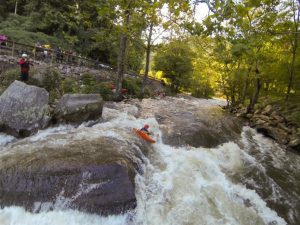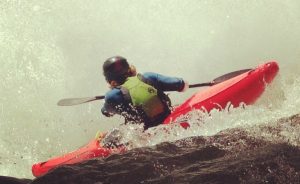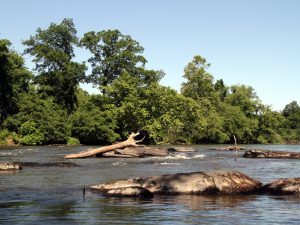Across the Great Smoky Mountains National Park, miles of interconnected trails meander through lush, green valleys, hug the banks of moss-laden, rocky creeks, and climb through thickets of mountain laurel and rhododendron to the blue-tinged mountain peaks.
You could spend weeks backpacking through this rich landscape, but a weekend trip will also allow you to experience the best of the Smokies. To help you plan your visit, we’ve highlighted three backpacking loops that give you the Appalachian Trail, streamside and ridgeline campsites, killer views, and enough distance and elevation to satisfy your inner weekend warrior.
Big Creek Loop
Combining the best of front-country and backcountry camping, the Big Creek area on the northeastern tip of the park off I-40 offers something for every level of hiker. Tackle a 21.5-mile loop over big peaks or lower your mileage and elevation with a night at one of the sweetest creekside campsites in the park. Either way, you’ll hike the AT through some of the most scenic terrains in the Smokies.

Rock/Creek
Roll into Big Creek Friday night to enjoy campground amenities like restrooms, dinner at a picnic table, and campsites with fire rings. You’ll be up early on Saturday to climb the Chestnut Branch Trail 2 miles to the Appalachian Trail. One of the shortest AT access points, the trail passes the remains of homesteads that pre-date the national park.
Turn south on the AT and continue climbing 3.3 miles to the 0.6-mile Mt. Cammerer fire tower spur trail. At 4,928 feet, the tower overlooks the Pigeon River Gorge to the north and Mt. Sterling to the south. From the fire tower, it’s a moderate descent 2.1 miles to the Low Gap Trail. Take Low Gap 2.5 miles to campsite #37 at the Big Creek Trail junction. Right on the banks of Big Creek, you’d be hhard-pressedto find a more spacious backcountry site in the park.
On Sunday, you can go big or go home, as they say. Going big means a hike up the Swallow Falls Trail 4 miles to the Mt. Sterling Ridge Trail. It’s another 1.4 miles and more climbing to an elevation of 5,842 feet on Mt. Sterling. Climb Sterling’s 60-foot steel fire tower for panoramic views of Cataloochee Valley, the Black Mountains, and the Southern Appalachians. Now, the downhill endurance test begins, with a 4,000-foot elevation loss over 6 miles on the Baxter Creek Trail. If you opt to go home, you can sleep in, savor your coffee by the campfire, and still have plenty of time to hike the moderate, 5-mile descent along Big Creek back to the campground, passing two stunning waterfalls and plenty of swimming holes along the way.

virgntn2011
Big Creek Campground is open from April through October and makes a great base camp for groups by serving a wide variety of abilities and interests. On your way home, make sure you leave enough time to refuel at Carver’s Apple Orchard in Cosby, Tenn. At Carver’s you can shop for fresh produce at the farmers market, nab awesome treats at an old-time candy shop, and feast at a homestyle restaurant, where the apple fritters are not to be missed.
Twentymile Loop
In the southwest corner of the Smokies, you’ll find a lesser-used trailhead that leads to the AT and one of the most scenic balds in the park. From this trailhead, you’ll log 17.6 miles on the way to Gregory Bald, sleeping one night on the AT and camping the other night on the bald.
Start off Friday afternoon at the Twentymile Ranger Station off Highway 28 near the border of North Carolina and Tennessee. A non-technical climb takes you 4.5 miles to meet the AT at Sassafras Gap. Campsite #113, at Birch Spring Gap, is less than 1 mile north of the trail junction. If time allows late Friday or early Saturday morning, head south on the AT for 360-degree views at sunset or sunrise from the top of Shuckstack Fire Tower. The historic lookout isn’t regularly maintained, so watch your step on the 200-foot climb to the top.

Chris M Morris
You’ll resume your northward journey on the AT, traveling 2 miles over Doe Knob to the next trail junction. Next, take Gregory Bald Trail west a little more than 3 miles to campsite #13 on the bald. Known for spectacular flame azalea blooms each year in mid to late June, the grassy high-elevation meadow offers stunning views of Cades Cove, Fontana Lake, and Clingmans Dome.
On Sunday, make the final 6.3-mile descent to the trailhead on the wide, non-technical Wolf Ridge Trail. Refuel at Fontana Village, just over 6 miles down Highway 28, before heading home. Burgers and brews will hit the spot at Wildwood Grill, while the Mountainview Restaurant highlights seasonal produce, along with fresh, local rainbow trout.
Deep Creek Loop

Alan Cressler
Enjoy the streams and waterfalls of the Deep Creek area in the south-central region of the Smokies on this 28.2-mile loop. You’ll also spend a night in an AT shelter and exit on one of the longest continuously descending trails in the Smokies.
You’ve barely left the Deep Creek Ranger Station before you come across Tom Branch Falls and Indian Creek Falls. Once you pass these Insta-worthy stops, it’s a slight uphill grade for 4 miles along the moderately rocky Deep Creek Trail to campsites 54-59. Claim a site for Friday evening (all but one are non-reservable) to enjoy the refreshing waters of Deep Creek and thickly wooded campsites.
Creek crossings and easy bushwacking are on the agenda Saturday, as you hike another 4 miles to the Fork Ridge Trail. Fork Ridge ascends 5 miles to Clingmans Dome Road and the AT. A short hike north takes you to the Mount Collins shelter, where you’ll spend the night in a high-elevation spruce-fir forest and dramatically cooler, drier conditions. Enjoy the shelter amenities, like cozy bunks and a fireplace inside.

Kevin Stewart Photography
The pre-dawn hike south to Clingmans Dome is highly recommended for 360 degrees of sunrise from the highest point in the Smokies. Hike 2 miles down Clingmans Dome Road to the Noland Divide Trailhead to start your final 11.4-mile descent. The trail slopes gently for the first 5 miles before making a steeper drop into Deep Creek, but there are few roots and rocks to slow you down. Make sure you stop to enjoy the views at Lonesome Pine Overlook along the way.
After logging all those miles, nothing’s going to taste more satisfying than a meal and craft beer at The Warehouse at Nantahala Brewing Co. Wrap up your Smokies adventure on the outdoor patio in downtown Bryson City with specialties like the slow-cooked brisket noodle bowl, apple bourbon pork chops, or Bryson City Brown Ale chicken along with a flagship or seasonal draft.
Featured image provided by Kevin Stewart Photography


















